Fake Railroad China: Reproductions
Railroad china is one of the most popular categories of railroad collectibles,
so it is not surprising that attempts have been made to reproduce it
in various ways. This new production ranges from responsibly produced
reproductions with backstamps that indicate their status to outright
fakes that are meant to deceive collectors.
The following information on reproduction railroad china was compiled
from several sources, including Bill
and Sue Knous who most generously gave us permission to post text
and material from their book Railroad Detective: A Guide to Replica
and Counterfeit Railroad Collectibles and Dick
Luckin, author of Dining on Rails, Teapot Treasury and Mimbres
to Mimbreno, who provided most of the china photos and information
for Bill and Sue's book. Other sources were members of the railnet list
and other collectors. See notes below for credits
and important information.
Bill and Sue Knous note that ,"The majority of [new] china has
not been produced with fraud in mind, but on the other hand has legitimately
been represented as reproduction. The problem is not with the manufacturers
or distributors but with the unscrupulous party whose greed comes to
play a part. Also many of the pieces were not permanently marked reproduction,
they are easily misrepresented to the unknowing collector as authentic.
The fakers will go as far as to age, scrape, grind off bottom stamps,
even damage a piece to help give appearance of age and authenticity.
The one thing we must keep in mind also, due to the vast amount of fakery
that is showing up on the market every day, it is important to note that
even though it is an unknown pattern, this does not make it a fake. One
of the things that makes this so much fun is the thought of finding that
rare piece. We do the hobby a disservice if we assume a piece no good
simply because it has not been seen before.
One more important factor in collecting railroad china involves the
distinction between OVERGLAZE & UNDERGLAZE. This excerpt is from
Dick Luckin's "Dining on Rails." The way you distinguish an
OVERGLAZE from an UNDERGLAZE is by running your finger over the design.
If you can feel the imprint, it's an OVERGLAZE. If you can't feel the
imprint, it's an UNDERGLAZE. Keep in mind ALL railroads ordered UNDERGLAZED
patterns, because of the increased durability and increased life span
of the ware."
Following are railroad china reproductions, counterfeits, and replicas.
A separate page deals with "fantasy
patterns" -- patterns that were never used on a railroad.
 Santa
Fe Railroad "Mimbreno" pattern: This pattern has been
reproduced by Pipestone China which was founded as Nostalgia Station Ltd.and which obtained exclusive authorization
from the Santa Fe Railway to reproduce it. Early pieces in the line were backstamped with
a Nostalgia Station mark (click on the backstamp at right for a larger image), but we have learned that there are also pieces -- likely more recently made -- that have a Pipestone backstamp. The current backstamp is not known, but it may be the Pipestone mark. Santa
Fe Railroad "Mimbreno" pattern: This pattern has been
reproduced by Pipestone China which was founded as Nostalgia Station Ltd.and which obtained exclusive authorization
from the Santa Fe Railway to reproduce it. Early pieces in the line were backstamped with
a Nostalgia Station mark (click on the backstamp at right for a larger image), but we have learned that there are also pieces -- likely more recently made -- that have a Pipestone backstamp. The current backstamp is not known, but it may be the Pipestone mark.
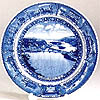 |
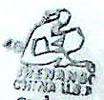 |
 Baltimore & Ohio "Centenary" pattern. This
pattern used extensively by the B&O Railroad since 1927 (See Centenary)
and was so popular that it was produced after the railroad ceased passenger
service as souvenir items for the B&O Museum in Baltimore. This post-railroad
china has a black "Indian" stamp on the back and was produced
by Shenango-Interpace. Update: Jim Hutzler wrote us
with this very informative comment: "The black backstamped "Interpace" Shenango
pieces are date coded between T-27 and F-33, indicating production
during the years 1969-1975.
Prior to the "Interpace" china production,
another black backstamped version was produced, without the word "interpace" and
with the word "RimRol" located approximately in the same place.
Almost all RimRol pieces have the date codes G-26 or R-26, indicating
that these were produced in 1968.
It is absolutely confirmed that both Interpace
and RimRol backstamped china was used on B&O/C&O dining cars
during the last years of C&O/B&O dining service. This
edition, along with the subsequent 1970s and 1990s editions which
were also sold out of the B&O Museum gift shop and other outlets,
continued to be used on company office cars (although information obtained in early 2007 indicates that this is no longer the case).
So, to simply identify any of the Centenary
pattern china, which was produced virtually continually between
1927 and 1997, as reproduction, is not completely accurate." [end of
comment - thanks, Jim!] Baltimore & Ohio "Centenary" pattern. This
pattern used extensively by the B&O Railroad since 1927 (See Centenary)
and was so popular that it was produced after the railroad ceased passenger
service as souvenir items for the B&O Museum in Baltimore. This post-railroad
china has a black "Indian" stamp on the back and was produced
by Shenango-Interpace. Update: Jim Hutzler wrote us
with this very informative comment: "The black backstamped "Interpace" Shenango
pieces are date coded between T-27 and F-33, indicating production
during the years 1969-1975.
Prior to the "Interpace" china production,
another black backstamped version was produced, without the word "interpace" and
with the word "RimRol" located approximately in the same place.
Almost all RimRol pieces have the date codes G-26 or R-26, indicating
that these were produced in 1968.
It is absolutely confirmed that both Interpace
and RimRol backstamped china was used on B&O/C&O dining cars
during the last years of C&O/B&O dining service. This
edition, along with the subsequent 1970s and 1990s editions which
were also sold out of the B&O Museum gift shop and other outlets,
continued to be used on company office cars (although information obtained in early 2007 indicates that this is no longer the case).
So, to simply identify any of the Centenary
pattern china, which was produced virtually continually between
1927 and 1997, as reproduction, is not completely accurate." [end of
comment - thanks, Jim!]
 Chesapeake & Ohio "Chessie" logo. A
C&O piece with the "Chessie Cat" image was recently
sold by Nostalgia Station. The best way to watch for C&O pieces
which are becoming increasingly popular is to know the facts. The
cat appeared on Buffalo manufactured service plates, salmon bordered
dinner plates and a child's dish, as well as a dinner plate, cup
and ashtray manufactured by Syracuse. If you see it by other manufacturers
or on different pieces than noted, they were probably not railroad
issue. A Chessie cup & saucer was produced in 1988 by the C&O
Historical Society. All pieces are backstamped COHS 1988. See Below. Chesapeake & Ohio "Chessie" logo. A
C&O piece with the "Chessie Cat" image was recently
sold by Nostalgia Station. The best way to watch for C&O pieces
which are becoming increasingly popular is to know the facts. The
cat appeared on Buffalo manufactured service plates, salmon bordered
dinner plates and a child's dish, as well as a dinner plate, cup
and ashtray manufactured by Syracuse. If you see it by other manufacturers
or on different pieces than noted, they were probably not railroad
issue. A Chessie cup & saucer was produced in 1988 by the C&O
Historical Society. All pieces are backstamped COHS 1988. See Below.
   C&O "George
Washington" pattern: There reports of fake C&O Railway
demi-cups and saucers in the "George Washington" pattern.
These have the potential to fool collectors because they have
a backstamp. The real ones were made by Syracuse, and the back
of the saucer is white, not black. The backstamp on the real
version is under the glaze and in black lettering; whereas the
fake version has an overglazed backstamp in gold lettering. C&O "George
Washington" pattern: There reports of fake C&O Railway
demi-cups and saucers in the "George Washington" pattern.
These have the potential to fool collectors because they have
a backstamp. The real ones were made by Syracuse, and the back
of the saucer is white, not black. The backstamp on the real
version is under the glaze and in black lettering; whereas the
fake version has an overglazed backstamp in gold lettering.
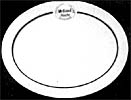  Colorado
Midland Ry "Basalt" pattern has been reproduced
in several pieces: dinner plates, bowls, cups and saucers, and
butter pats. Some of the butter pats were produced with the deletion
of the stripes. Mfg. STR. Backstamped "Colorado Midland
Chapter NRHS" with year of manufacture. Colorado
Midland Ry "Basalt" pattern has been reproduced
in several pieces: dinner plates, bowls, cups and saucers, and
butter pats. Some of the butter pats were produced with the deletion
of the stripes. Mfg. STR. Backstamped "Colorado Midland
Chapter NRHS" with year of manufacture.
 D&RG "Curecanti" pattern. This
pattern was reproduced in 1987 by Centennial Publications. Cups
and saucers as well as 9 3/4" dinner plates have been reproduced.
All pieces are backstamped with the year of manufacture and are
marked reproduction. With this piece in mind we have knowledge
of two different incidents involving the cups, where individuals
aged, cracked and even ground off the bottom STR manufacturer's D&RG "Curecanti" pattern. This
pattern was reproduced in 1987 by Centennial Publications. Cups
and saucers as well as 9 3/4" dinner plates have been reproduced.
All pieces are backstamped with the year of manufacture and are
marked reproduction. With this piece in mind we have knowledge
of two different incidents involving the cups, where individuals
aged, cracked and even ground off the bottom STR manufacturer's 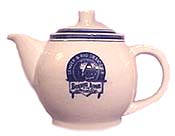 mark,
in hopes of representing these as authentic. Until caught the cups
traded hands several times for several hundred dollars each. mark,
in hopes of representing these as authentic. Until caught the cups
traded hands several times for several hundred dollars each.
There have been other attempts to fake this pattern in a not-so-subtle
blue version. The real thing was issued in black and brown markings
on a white base, had a manufacturer's mark on the bottom, and last
dates to the 1920's. It is quite rare. The fake china is blue,
has no manufacturer's mark on the bottom, and seems to have fairly "fuzzy" markings.
See example at right.
   Erie "Starucca" pattern": Plates
identical to the original Starucca pattern were manufactured by
Mayer China for a restaurant in New Jersey. Erie "Starucca" pattern": Plates
identical to the original Starucca pattern were manufactured by
Mayer China for a restaurant in New Jersey.
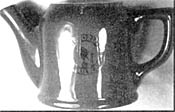  Great
Northen Railway. A modern, green Great Northern Railway teapot
has been made with a modern Hall backstamp. A number of reproduction
teapots have been recently produced with logos of different railroads,
usually in green or cobalt base colors. Some of these are backstamped
clearly as reproductions, but some are not. Great
Northen Railway. A modern, green Great Northern Railway teapot
has been made with a modern Hall backstamp. A number of reproduction
teapots have been recently produced with logos of different railroads,
usually in green or cobalt base colors. Some of these are backstamped
clearly as reproductions, but some are not.
 Great
Northern "Glory of the West" pattern. Pieces in
this pattern were reproduced in the early '90's for the lsaak
Walton Inn in Essex, Montana for their dining room. Manufactured
by Syracuse, these pieces carry the 19D date code indicating
production in 1991. All pieces are backstamped with "REPRODUCED
FOR ISSAK WALTON INN" with the exception of the 5 1/8" sauce
dish which only carries the GNRY "GLORY OF THE WEST" bottom
stamp. In this case the "GLORY OF THE WEST" bottom
stamp is done in green instead of gray. Also the bottom stamp
is much smaller than the original and finally it does not state "MADE
FOR" which the originals do. Great
Northern "Glory of the West" pattern. Pieces in
this pattern were reproduced in the early '90's for the lsaak
Walton Inn in Essex, Montana for their dining room. Manufactured
by Syracuse, these pieces carry the 19D date code indicating
production in 1991. All pieces are backstamped with "REPRODUCED
FOR ISSAK WALTON INN" with the exception of the 5 1/8" sauce
dish which only carries the GNRY "GLORY OF THE WEST" bottom
stamp. In this case the "GLORY OF THE WEST" bottom
stamp is done in green instead of gray. Also the bottom stamp
is much smaller than the original and finally it does not state "MADE
FOR" which the originals do.
 New
Haven Beanpot. The original, shown far right, is actually
more crude than the reproduction, shown near right. The real
thing has a rubber stamp decoration; whereas the reproduction
uses an overglazed decal. The color variation is the most obvious
difference. New
Haven Beanpot. The original, shown far right, is actually
more crude than the reproduction, shown near right. The real
thing has a rubber stamp decoration; whereas the reproduction
uses an overglazed decal. The color variation is the most obvious
difference.
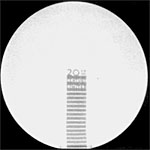  New
York Central "Century" pattern: This plate made
in 1987 by THE PRIVATE CAR LIMITED and is well marked as a reproduction. New
York Central "Century" pattern: This plate made
in 1987 by THE PRIVATE CAR LIMITED and is well marked as a reproduction.
 New
York Central "DeWitt Clinton" pattern: This plate
is easily detected since the New
York Central "DeWitt Clinton" pattern: This plate
is easily detected since the 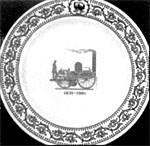 original only had the 1831 date
under the top logo. Original dinner plates did not have a center
crest. Made in 1981 by the Mohawk & Hudson Chapter of the
NRHS and produced by Syracuse. This is another well marked reproduction
item. original only had the 1831 date
under the top logo. Original dinner plates did not have a center
crest. Made in 1981 by the Mohawk & Hudson Chapter of the
NRHS and produced by Syracuse. This is another well marked reproduction
item.
   Nickel
Plate Road "Bellevue" pattern: This oval dinner
plate is an excellent copy of the original. Reproduction bottom
stamp has addition of ALCO STANDARD CORP added to bottom stamp. Nickel
Plate Road "Bellevue" pattern: This oval dinner
plate is an excellent copy of the original. Reproduction bottom
stamp has addition of ALCO STANDARD CORP added to bottom stamp.
 MKT "Bluebonnet" pattern": A
reproduction of the "Bluebonnet" china pattern used by
the Missouri Kansas Texas Railroad, A.K.A. "Katy", has
recently been produced. Chris Cruz has kindly provided the following
review of this new reproduction china: MKT "Bluebonnet" pattern": A
reproduction of the "Bluebonnet" china pattern used by
the Missouri Kansas Texas Railroad, A.K.A. "Katy", has
recently been produced. Chris Cruz has kindly provided the following
review of this new reproduction china:
 "There
are five pieces -- a dinner plate, a salad/bread & butter, an oatmeal
bowl, and a coffee cup and saucer. The ware itself is very close
in shape to the originals with the exception of the coffee cup.
It is mug shaped, but definitely not the same in handle design
nor bottom construction. The base ware is not quite as white in
color as the originals. The mint green band is an exact match.
From a distance, most would not be able to note the difference
in the flowers. The green stems and leaves are also very close
to the original. The flowers on the stems of the reproduction are
basically the same except they lack "softness" and a muted color.
The originals are almost cotton like in quality. The reproduction
has more artistic definition, like the stems. On several of the
pieces, the decal appears to be thicker and thus, raise the glaze. "There
are five pieces -- a dinner plate, a salad/bread & butter, an oatmeal
bowl, and a coffee cup and saucer. The ware itself is very close
in shape to the originals with the exception of the coffee cup.
It is mug shaped, but definitely not the same in handle design
nor bottom construction. The base ware is not quite as white in
color as the originals. The mint green band is an exact match.
From a distance, most would not be able to note the difference
in the flowers. The green stems and leaves are also very close
to the original. The flowers on the stems of the reproduction are
basically the same except they lack "softness" and a muted color.
The originals are almost cotton like in quality. The reproduction
has more artistic definition, like the stems. On several of the
pieces, the decal appears to be thicker and thus, raise the glaze.
Now for the main point which has prompted major concern -- there
is no reproduction backstamp. The ONLY backstamp is the green, rubber stamp
shape of a buffalo. Some have the word BUFFALO under the animal. A date code
will also be evident, such as 9907D, 9810M, and 9811A, to cite as examples.
Confusion with authentic MKT Bluebonnet will occur unless one is very careful.
A website visitor emailed us the following in 2006: "The bluebonnet
MKT pattern was commissioned by the KATY House in Smithville, Texas. I
know that this was done just for people who like the pattern and wish
to enjoy it daily and not to confuse it for anyone." Above
Right: An authentic Bluebonnet plate. Click on image for larger version.
  PRR "Brown
Keystone" pattern: Pieces were produced in 1986 and
are accurate in color and design to the original pattern. Pieces
include a 9" dinner, 7 1/4" bread plate, 5 1/2" plate,
5 1/4" fruit and a cup & saucer. All pieces are permanently
marked with bottom stamp "REPRODUCTION MADE EXPRESSLY FOR
RIGHT TRACKTRADING CO." PRR "Brown
Keystone" pattern: Pieces were produced in 1986 and
are accurate in color and design to the original pattern. Pieces
include a 9" dinner, 7 1/4" bread plate, 5 1/2" plate,
5 1/4" fruit and a cup & saucer. All pieces are permanently
marked with bottom stamp "REPRODUCTION MADE EXPRESSLY FOR
RIGHT TRACKTRADING CO."
 Union
Pacific patterns. These photos show the work of one individual
whose sole purpose was to defraud the collector. These pieces
were exceptionally well made and fooled many seasoned collectors.
Unfortunately the perpetrator was also a collector so the find
was given even more credibility. The party obtained plain pieces
of china with the correct manufacturer backstamp and overglazed
the logos shown. The overglaze process was the clue in identifying
the items as faked. The party involved was brought to justice
and ordered to pay restitution. All faked items were ordered
to be returned and destroyed. Unfortunately there is no proof
that all pieces have in fact been returned and destroyed. Many Union
Pacific patterns. These photos show the work of one individual
whose sole purpose was to defraud the collector. These pieces
were exceptionally well made and fooled many seasoned collectors.
Unfortunately the perpetrator was also a collector so the find
was given even more credibility. The party obtained plain pieces
of china with the correct manufacturer backstamp and overglazed
the logos shown. The overglaze process was the clue in identifying
the items as faked. The party involved was brought to justice
and ordered to pay restitution. All faked items were ordered
to be returned and destroyed. Unfortunately there is no proof
that all pieces have in fact been returned and destroyed. Many 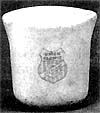 questionable
pieces have surfaced at farm auctions and flea markets. Know
your source and remember if the price is too good, it probably
is fake. Pieces include a UP "Ogden" pattern creamer
pot. Other pieces in this pattern included two different sized
oval platters, shallow rimmed bowl, oval baker, dinner plate,
small handled creamer & butter pat. Another series of fakes
included a UP "Overland Route" pattern cream pitcher,
pedestal egg cup, and no handle creamer. Also there is a UP "North
Platte" bouillon cup. questionable
pieces have surfaced at farm auctions and flea markets. Know
your source and remember if the price is too good, it probably
is fake. Pieces include a UP "Ogden" pattern creamer
pot. Other pieces in this pattern included two different sized
oval platters, shallow rimmed bowl, oval baker, dinner plate,
small handled creamer & butter pat. Another series of fakes
included a UP "Overland Route" pattern cream pitcher,
pedestal egg cup, and no handle creamer. Also there is a UP "North
Platte" bouillon cup.
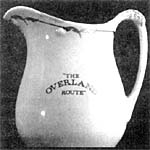 |
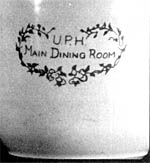 |
| Click
on the image below for a larger version. |
|
In addition to the above, there is an extensive list of reproduction
railroad china produced by a single individual. This list is presented
on a separate page.
Advice. As with other specialty areas of collecting, the
advice about self-education and seeking the advice of other collectors
applies especially to china. RCAI regularly
publishes information on china fakes and reproductions. In addition,
there are two fine publications that discuss this topic along with
other aspects of railroad china: Dick Luckin's "Dining
on Rails" and Doug McIntyre's "The
Official Guide to Railroad Dining Car China".
Comments. The following comment was sent by B.K. " Many
railroads have museums in
which memorabilia are sold to generate revenue to keep the doors open. One
of the products is chinaware. This chinaware is made under the scrutiny of
the curator and originality is demanded. Most of the original chinaware manufacturers
have long since gone out of business, so the current ware does have a backstamp
not displayed pre Amtrak,
whatever that means.
Current ware is not "Fake". It is a reproduction (as
was all chinaware after an original order) made under the direction
of the subject railroad to meet authenticity. This ware has not
been used in actual RR service, but then, alot of chinaware made
in "the good 'ol days" that is
considered collectible was not put in service either. It seems that being in
service is the underlying theme of originality, which is incorrect."
Notes
This information comes with no guarantees and is advisory only.
See Disclaimer and Things to Consider.
Bill and Sue Knous operate one of the premier railroadiana auction
services, Railroad Memories,
and consequently are well-positioned to know about railroadiana
fakes and reproductions. They have been very generous in sharing
information with the hobby, and we thank them for their gracious
permission to reprint the information that they have compiled.
Also special thanks to Dick Luckin who provided many of the original
china images and information.
Other collectors who contributed information and/or images: Tom
and Meg Coughlin, Dave Yates, Chris Cruz, Dave H., Bob K. and others.
Thanks to everyone!
We
welcome additions, information, and images for this page. In particular,
we need better color images to replace the black & white ones. Email
Us. |